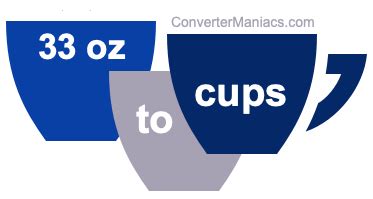How Many Cups In 33 Oz
Kalali
Apr 02, 2025 · 4 min read

Table of Contents
How Many Cups in 33 oz? A Comprehensive Guide to Volume Conversions
The question, "How many cups are in 33 oz?" might seem simple, but it delves into the fascinating world of volume conversions, highlighting the importance of precision and understanding different measurement systems. This comprehensive guide will not only answer this specific question but also provide you with the tools and knowledge to tackle similar conversions with ease. We'll explore various methods, address common misconceptions, and provide practical examples to solidify your understanding.
Understanding Fluid Ounces and Cups
Before diving into the conversion, let's clarify the units involved. We're dealing with fluid ounces (fl oz), a unit of volume in the imperial and US customary systems, and cups (c), another common unit of volume, also part of the same systems. It's crucial to note that there's a difference between fluid ounces and ounces (oz) used for weight – these are not interchangeable.
The relationship between fluid ounces and cups is fundamental to our conversion. The standard conversion is: 1 cup = 8 fluid ounces. This is a crucial piece of information that forms the basis of all our calculations.
Calculating Cups from Fluid Ounces: The Basic Method
The most straightforward method for converting 33 fluid ounces to cups involves simple division. Since 1 cup equals 8 fluid ounces, we divide the total fluid ounces by 8:
33 fl oz / 8 fl oz/cup = 4.125 cups
Therefore, there are 4.125 cups in 33 fluid ounces.
Understanding the Decimal: Beyond the Whole Number
The result of 4.125 cups highlights an important point: volume conversions often don't yield perfectly whole numbers. The ".125" represents a fraction of a cup. To better understand this fraction, we can convert it into other units:
- Fractions: 0.125 is equivalent to 1/8 of a cup.
- Tablespoons: Since there are 16 tablespoons in 1 cup, 0.125 cups is equal to 2 tablespoons (0.125 cups * 16 tablespoons/cup = 2 tablespoons).
Knowing this allows for more precise measurements in cooking or other applications requiring specific quantities.
Practical Applications and Real-World Examples
Understanding this conversion is essential in various situations:
-
Cooking and Baking: Recipes often list ingredients in both cups and ounces. Knowing how to convert between them is crucial for accurate results. Imagine a recipe requiring 33 fl oz of milk; you'd know to measure out 4 and 1/8 cups.
-
Serving Sizes: When planning a party or event, calculating the total volume of drinks needed often involves converting between ounces and cups. If you need 33 fl oz of juice, you'll need 4.125 cups, allowing you to properly size your serving containers.
-
Liquid Measurement in Science: Many scientific experiments involve measuring liquids precisely. Converting between units is necessary to ensure the accuracy of the experiment.
Advanced Conversion Scenarios: Dealing with Different Systems and Units
While the US customary system is used in the US, the metric system (liters, milliliters) is dominant globally. Sometimes, you'll need to convert between these systems as well.
Converting between US Customary and Metric:
The conversion between fluid ounces and milliliters is approximately: 1 fl oz ≈ 29.57 ml. If you have a volume in milliliters, you can convert it to fluid ounces and then to cups using the methods outlined above.
Example: Let's say you have 930 ml of liquid. Converting to fluid ounces: 930 ml / 29.57 ml/fl oz ≈ 31.45 fl oz. Then, converting to cups: 31.45 fl oz / 8 fl oz/cup ≈ 3.93 cups.
Avoiding Common Conversion Mistakes
Several common mistakes can lead to inaccurate results:
-
Confusing weight and volume: The most frequent error is mixing up ounces (weight) and fluid ounces (volume). They're not interchangeable.
-
Using incorrect conversion factors: Double-check your conversion factor (1 cup = 8 fl oz) to ensure accuracy.
-
Rounding errors: While rounding is sometimes necessary, excessive rounding can accumulate errors, especially in complex conversions involving multiple steps.
Tools and Resources for Volume Conversions
Numerous online tools and calculators are readily available to assist with volume conversions. These calculators often provide detailed steps and handle various units, simplifying the process. However, understanding the underlying principles remains essential for verifying the calculator's results and handling conversions independently.
Conclusion: Mastering Volume Conversions for Everyday Use
Converting 33 fluid ounces to cups is a straightforward calculation, yielding 4.125 cups, or 4 and 1/8 cups. However, the process underscores the importance of understanding units, employing correct conversion factors, and carefully handling decimal values. Mastering these conversions is valuable in various daily tasks, from cooking and baking to scientific measurements. By understanding the underlying principles and employing the methods outlined in this comprehensive guide, you'll become confident in tackling various volume conversion challenges. The ability to accurately and efficiently convert between different units of volume ensures precision and accuracy in various aspects of life, enhancing your problem-solving skills and fostering a deeper understanding of measurement systems. Remember to practice regularly to solidify your understanding and improve your proficiency in performing these essential calculations.
Latest Posts
Latest Posts
-
How Many Fahrenheit Is 160 Celsius
Apr 03, 2025
-
What Is 40 Percent Of 160
Apr 03, 2025
-
What Is 1820 In Military Time
Apr 03, 2025
-
How To Find Domain Of A Function Algebraically
Apr 03, 2025
-
Water And Oil Homogeneous Or Heterogeneous
Apr 03, 2025
Related Post
Thank you for visiting our website which covers about How Many Cups In 33 Oz . We hope the information provided has been useful to you. Feel free to contact us if you have any questions or need further assistance. See you next time and don't miss to bookmark.
